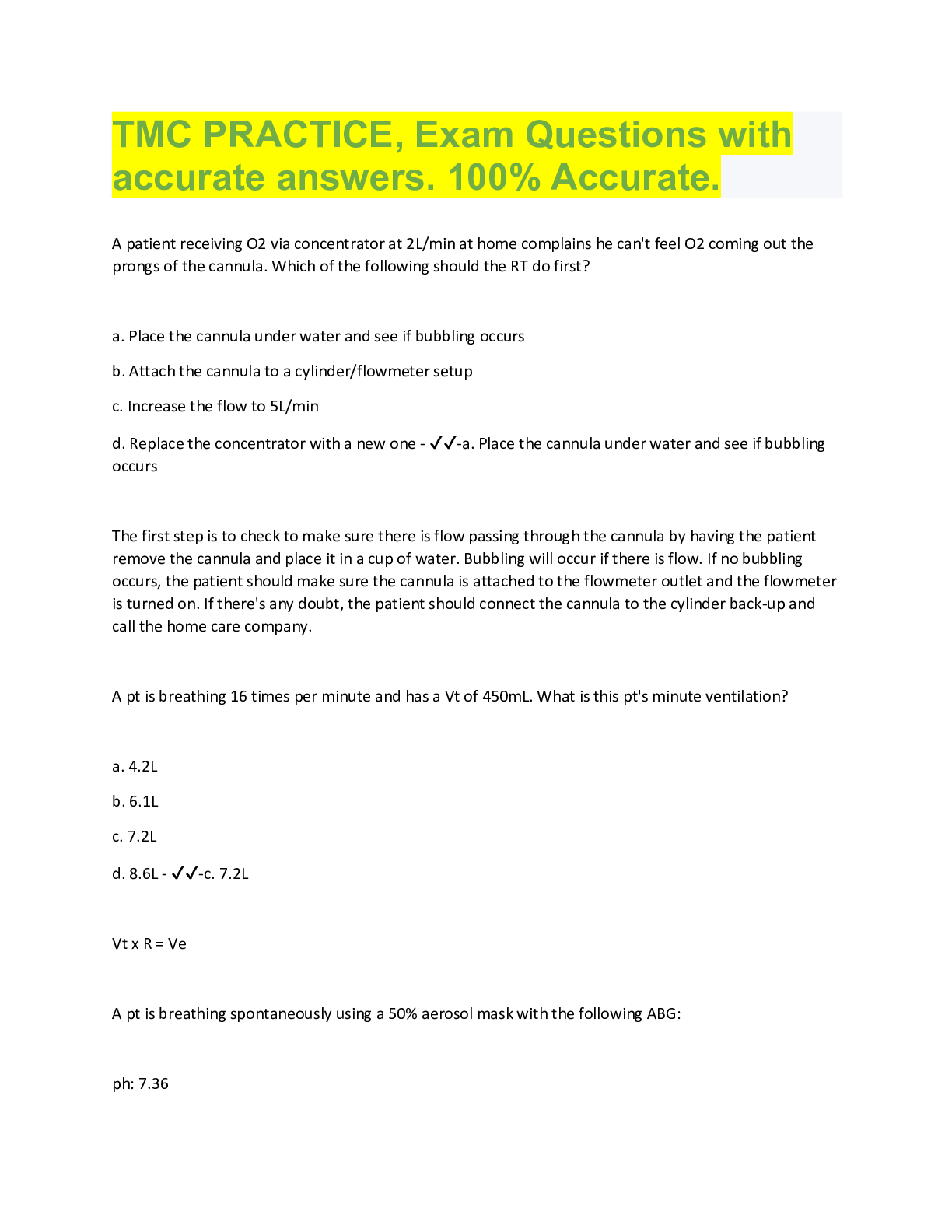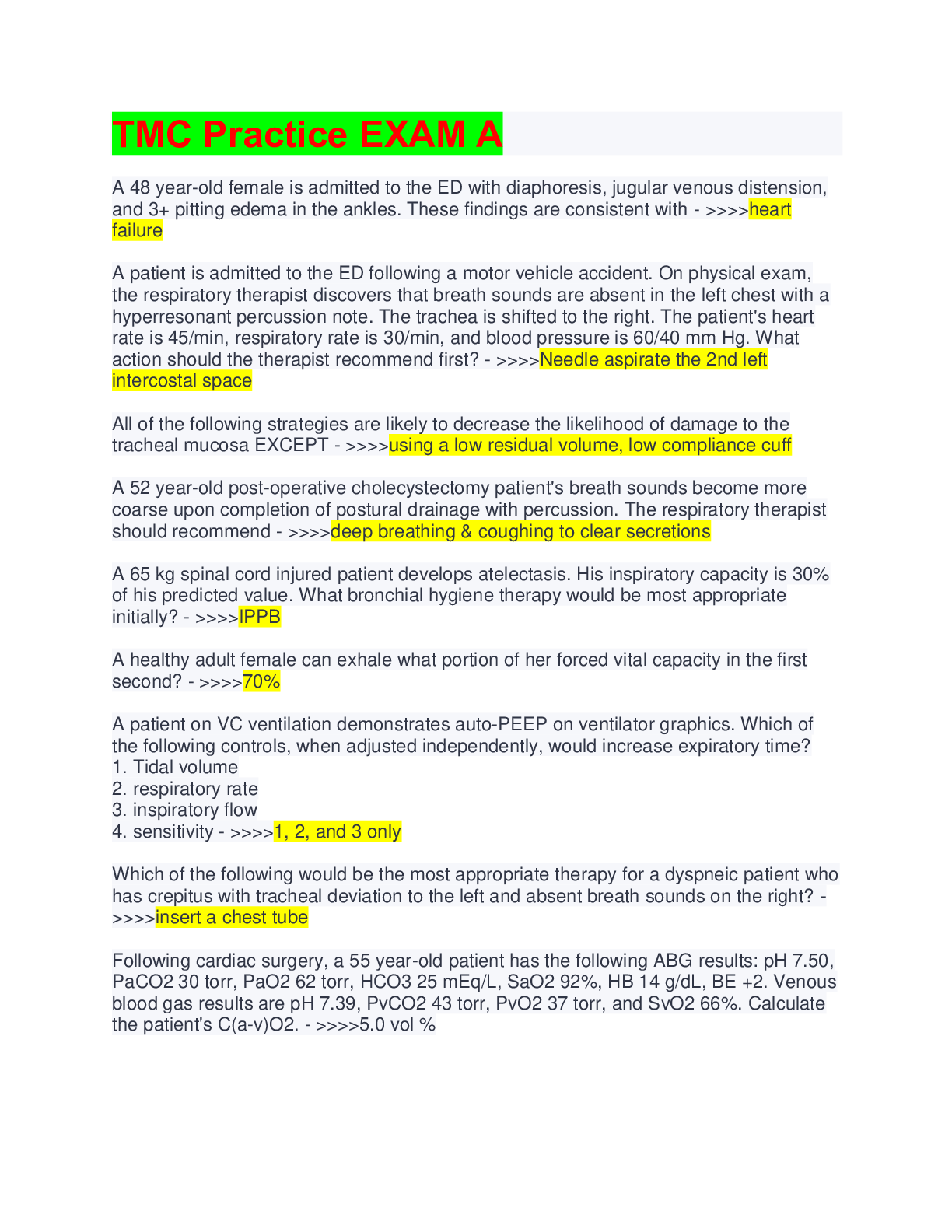*NURSING > QUESTIONS & ANSWERS > NR 304 Final Exam practice Comprehensive 302/304 Answers on last page (77 questions with 100% correc (All)
NR 304 Final Exam practice Comprehensive 302/304 Answers on last page (77 questions with 100% correct answers)
Document Content and Description Below
NR 304 Final Exam practice Comprehensive 302/304 Answers on last page 1. Which assessment by the nurse most likely indicates that a patient is having difficulty breathing? a. 18 breaths per minute... and inhaled through the mouth b. 20 breathes per minute and shallow in character c. 16 breaths per minute and deep in character d. 28 breaths per minute and noisy 2. Which should a nurse always do when taking a rectal temperature? a. Allow self-insertion of the thermometer. b. Position the patient on the left side. c. Use an electronic thermometer. d. Lubricate the thermometer. 3. A nurse is assessing a patient’s ideal body weight. Which significant factor should be takin into consideration when performing this assessment? a. Daily intake b. Body height c. Clothing size d. Food preferences 4. A nurse asks a patient’s wife specific questions about the patient’s health status before admission. When collecting this information, the nurse is seeking information from a: a. Primary source b. Tertiary sources c. Subjective source d. Secondary source 5. A nurse is preforming a physical assessment of a newly admitted patient. Which patient statement communicates subjective data? a. “I have sores between my toes.” b. “I dye my hair but it is really gray.” c. “My joints hurt when I get up in the morning.” d. “My left leg drags on the floor when I am walking.” 6. A nurse takes a patient’s blood pressure and records a diastolic pressure of 120 mm Hg. Which should the nurse do first? a. Notify the primary health-care provider. b. Retake the blood pressure. c. Notify the nurse in charge. d. Take the other vital signs. 7. A patient had a stroke that resulted in paralysis of the right side. When clustering data, the nurse grouped the following together: drooling of saliva and slurred speech. Which information is most significant to include with this clustered data? a. Receptive aphasia b. Inability to ambulate c. Difficulty swallowing d. Incontinence of bowel movements 8. A patient who experienced a stroke has left-sided hemiparesis and is incontinent of urine. Which is an appropriately worded nursing diagnosis for this patient? a. The patient has a need to maintain skin integrity. b. The patient has a stroked evidenced by hemiparesis and incontinence. c. The patient will be clean and dry and will receive range-of-motion exercises every four hours. d. The patient is at risk for impaired skin integrity related to left-sided hemiparesis and incontinence. 9. A nurse uses the interviewing process of clarification when interviewing a patient. Which is the nurse doing when this communication technique is used? a. Paraphrasing the patient’s message b. Restating what the patient has said c. Reviewing the patient’s communication d. Verifying what is implied by the patient 10. A patient has dependent edema of the ankles and feet and is obese. Which diet should the nurse expect the primary health-care provider to order? a. Low in sodium and high in fat b. Low in sodium and low in calories c. High in sodium and high in protein d. High in sodium and low in carbohydrates 11. A patient who is undergoing cancer chemotherapy says to the nurse, “This is no way to live.” Which response uses reflective techniques? a. “Tell me more about what you are thinking.” b. “You sound discouraged today.” c. “Life is not worth living?” d. “What are you saying?” 12. A nurse is assessing a patient who reports being incontinent. Which question should the nurse ask to elicit information related to urge incontinence? a. “Does urination occur immediately after coughing?” b. “Do you urinate small amounts of urine frequently?” c. “Do you begin urinating immediately after feeling the need to urinate?” d. “Does urination occur at predictable intervals without feeling the need to urinate?” 13. Which is the most common reason why older adults become incontinent of urine? a. They use incontinence to manipulate others. b. The muscles that control urination become weak. c. They tend to drink less fluid than younger patients. d. Their increase in weight places pressure on the bladder. 14. What is the nurse doing when formulating a nursing diagnosis? a. Planning b. Assessing c. Analyzing d. Implementing 15. A patient has just returned from surgery with an intravenous solution infusing and does not have a gag reflex. Which planned intervention takes priority? a. Observe the dressing for drainage. b. Ensure adequacy of air exchange. c. Check for an infiltration. d. Monitor vital signs. 16. To provide aseptically safe perineal care to all female patients, which should the nurse do? a. Use a different part of the washcloth for each stroke. b. Employ a circular motion when applying soap. c. Apply deodorant spray to the perineal are. d. Sprinkle talcum powder on the perineum. 17. A patient returns to the clinic after taking a 7-day course of antibiotic therapy and is still exhibiting signs of a urinary tract infection. Which should thebe the nurse’s initial action? a. Make an appointment for the patient to be seen by the primary health-care provider. b. Arrange for the primary health-care provider to prescribe a different antibiotic. c. Obtain another urine specimen for culture and sensitivity testing. d. Determine if the patient took the medication as prescribed. 18. A newly admitted patient was provided with a regular diet consisting of three traditional meals a day. After several days it was identified that he patient was eating only approximately 50% of the meals and was losing weight. What should the nurse do? a. Assist the patient until meals are completed., b. Schedule several between-meal supplements. c. Change the plan of care to provide five small meals daily. d. Secure an order to increase the number of calories provided. 19. After surgery, a patient reports mild incisional pain while performing deep-breathing and coughing exercises. Which is he nurse’s best response: a. “Each day it will hurt less and less.” b. “This is an expected response after surgery.” c. “With a pillow, apply pressure against the incision.” d. “I will get the pain medication that was prescribed. “ 20. An example of a goal identified by a nurse when planning a patient’s plan of care is, “The patient will: a. Maintain a weight of 140 pounds. b. Need small, frequent feedings. c. be at risk for weight loss. d. Be assisted with meals. 21. When obtaining a health history, the nurse identifies that a patient has gained 10 pounds in the past week. Which step of the nursing process is performed when the nurse documents this information in the patient’s clinical record? a. Analysis b. Planning c. Evaluation d. Assessment 22. A nurse is conducting an intake interview with a patient. Which should the nurse do first to facilitate therapeutic communication with this patient” a. Use probing questions. b. Teach about hygiene. c. Ask direct questions. d. Listen attentively. 23. Which concepts are important for the nurse to consider when interacting with others” Select all that apply. a. Personal appearance can be a source of information about a person. b. Progress notes are a form of nonverbal communication. c. Patients with expressive aphasia cannot communicate. d. Touch has various meanings to different people. e. Words have the same meaning for all people. 24. A patient has expressive aphasia because of a stroke. Which should the nurse do when caring for this patient? Select all that apply. a. Anticipate needs to reduce frustration. b. Teach the patient how to use a picture board. c. Encourage the patient to elaborate with gestures. d. Be patient when the patient is attempting to speak. e. Ask the patient questions that require a yes or no response. 25. Which is the primary source for assessing how a patient slept? a. Nurse b. Patient c. Patient’s roommate d. Nursing-care assistant 26. When a nurse goes into a room to take a patient’s temperature, the patient is drinking a cup of coffee. How long should the nurse wait to take the patient’s oral temperature? a. 5 minutes b. 7 minutes c. 15 minutes d. 30 minutes 27. The function of which part of the anatomy is reflected when the nurse obtains a radial pulse rate? a. Arteries b. Blood c. Heart d. Veins 28. A nurse is assessing the temperature of a patient. When can the nurse expect a patient’s temperature to be at its lowest? a. 6 am b. 10 am c. 6 pm d. 10 pm 29. When making rounds, the nurse finds a patient in bed with the eyes closed. Which should the nurse do? a. Return in a half hour to check on the patient b. Suspect that the patient is feeling withdrawn c. Allow the patient to continue sleeping d. Collect more data about the patient 30. A nurse takes the resting pulse of an older adult. Which pulse is within the expected range? a. 50 Beats per minute and irregular b. 90 beats per minute and regular c. 105 beats per minute and irregular d. 120 beats per minute and regular 31. A nurse obtains the rectal temperature of an adult. Which rectal temperature is within the expected range? a. 96.4 degrees F b. 97.6 degrees F c. 99.8 degrees F d. 101.2 degrees F 32. A nurse obtains blood pressures of several patients. Which blood pressure reading is considered the most hypertensive? a. `90/70 mm Hg b. 130/86 mm Hg c. 160/90 mm Hg d. 150/115 mm Hg 33. When assessing the heart rate of a patient, the nurse identifies a change in rate from 88 to 56 beats per minute. Which should the nurse do first? a. Wait a half hour and retake the pulse. b. Obtain the other vital signs. c. Ask about recent activity. d. Tell the nurse in charge. 34. A function of which part of the anatomy is primarily being assessed when a nurse obtains a patient’s pedal pulse? a. Veins b. Heart c. Blood d. Arteries 35. Which principle of blood pressure physiology should the nurse understand when assessing a patient’s cardiac function? a. The blood pressure reaches a peak followed by a trough. b. A peak pressure occurs when the left ventricle relaxes. c. The pulse pressure occurs during diastole. d. A trough pressure occurs during systole. [Show More]
Last updated: 1 year ago
Preview 1 out of 18 pages
Instant download

Instant download
Reviews( 0 )
Document information
Connected school, study & course
About the document
Uploaded On
May 17, 2021
Number of pages
18
Written in
Additional information
This document has been written for:
Uploaded
May 17, 2021
Downloads
0
Views
65

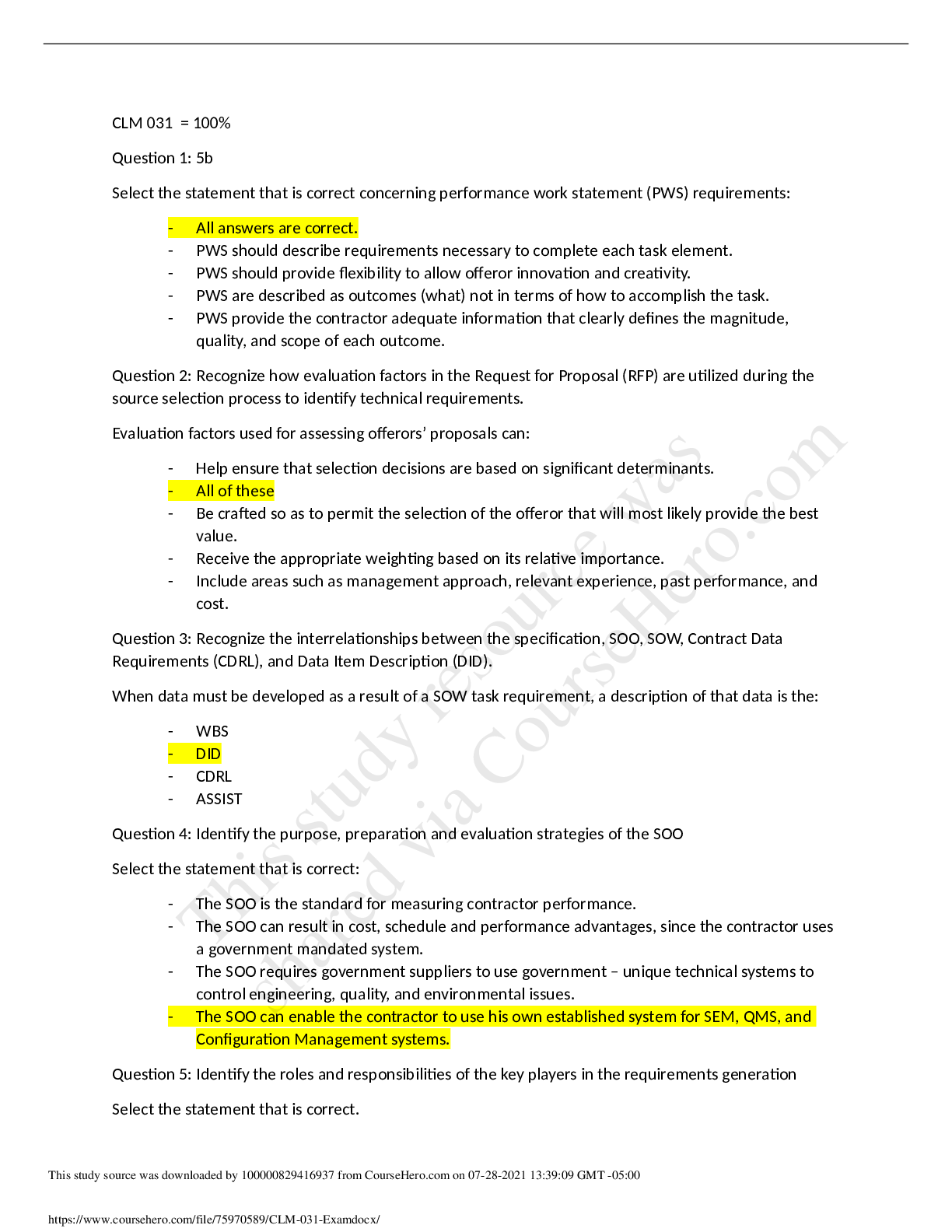



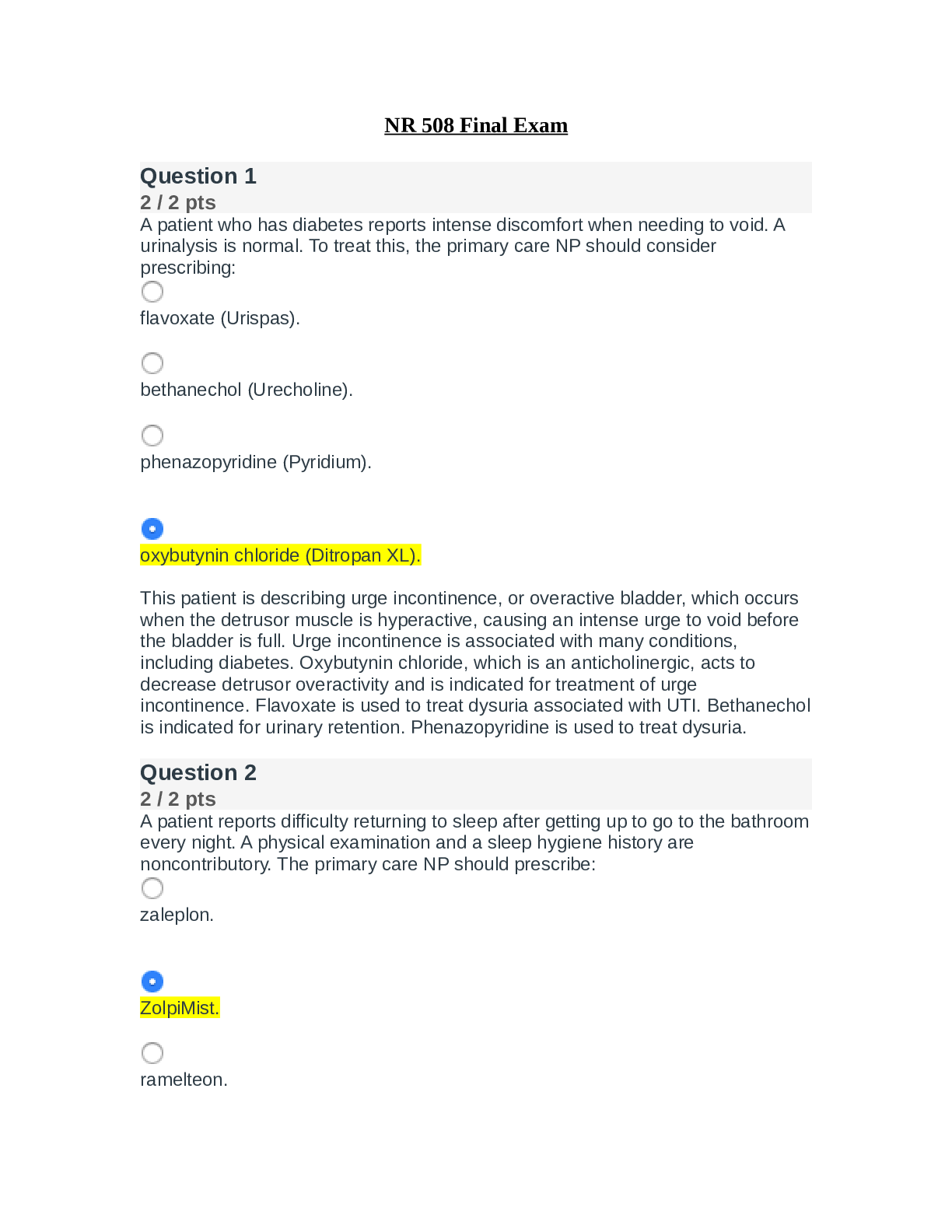
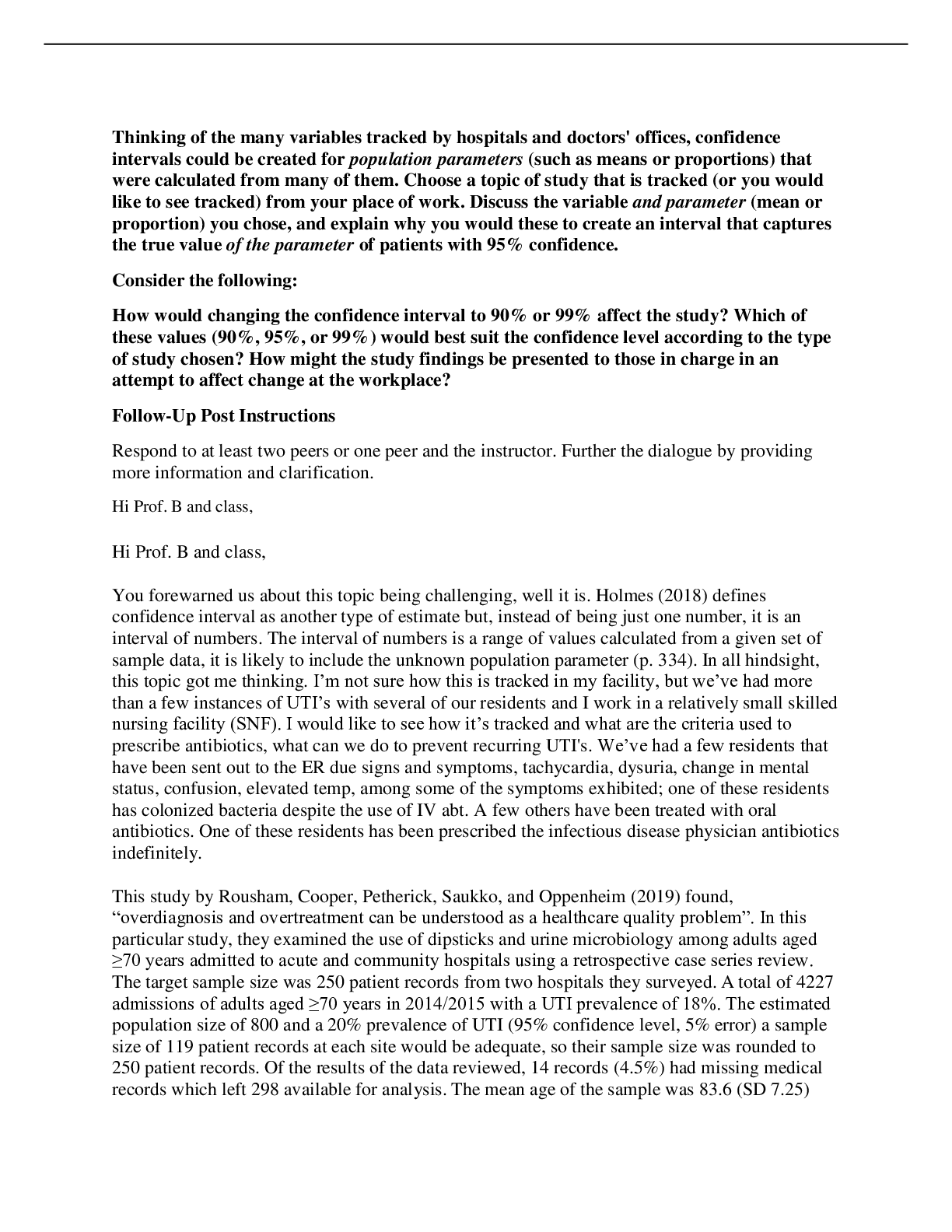

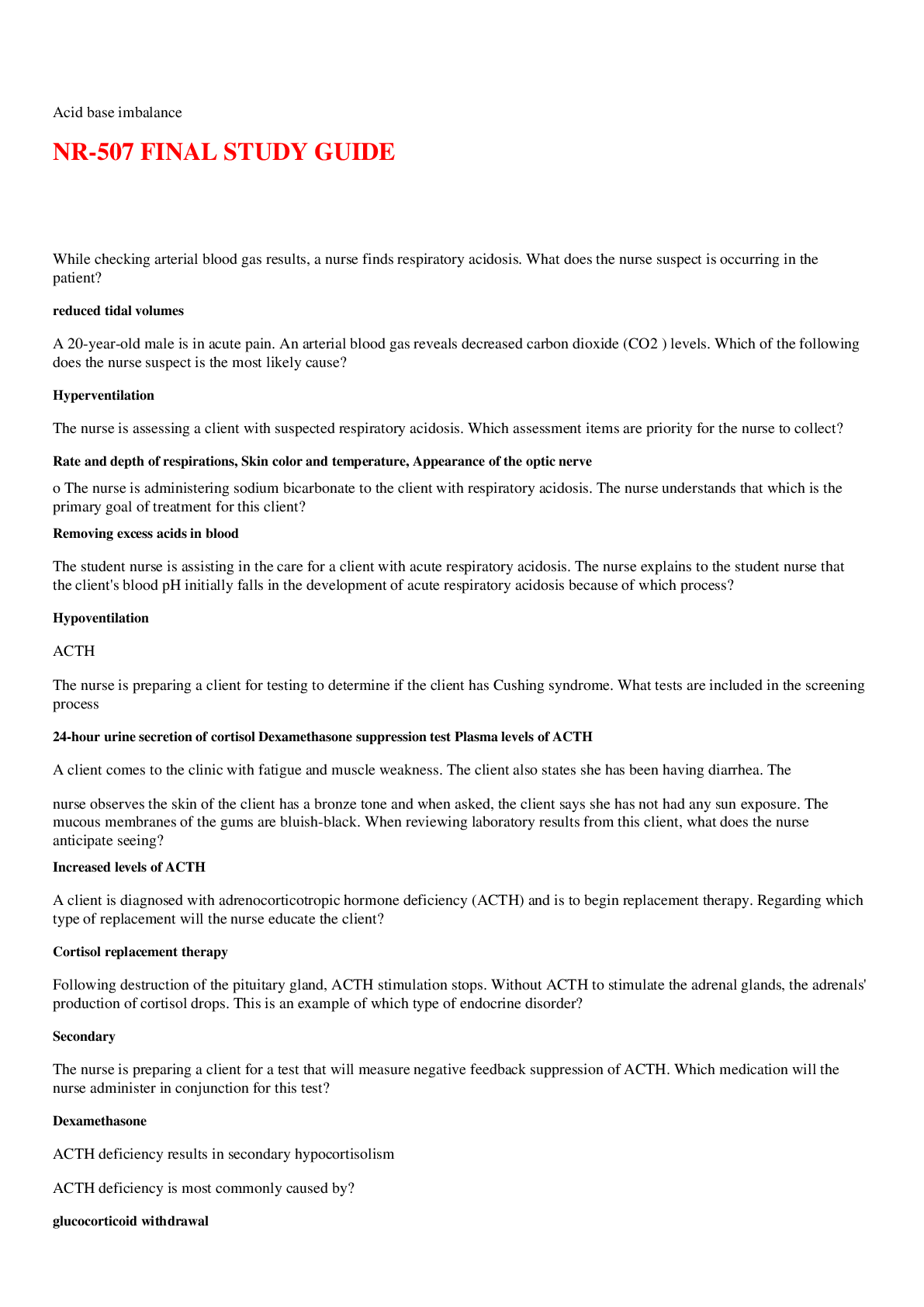



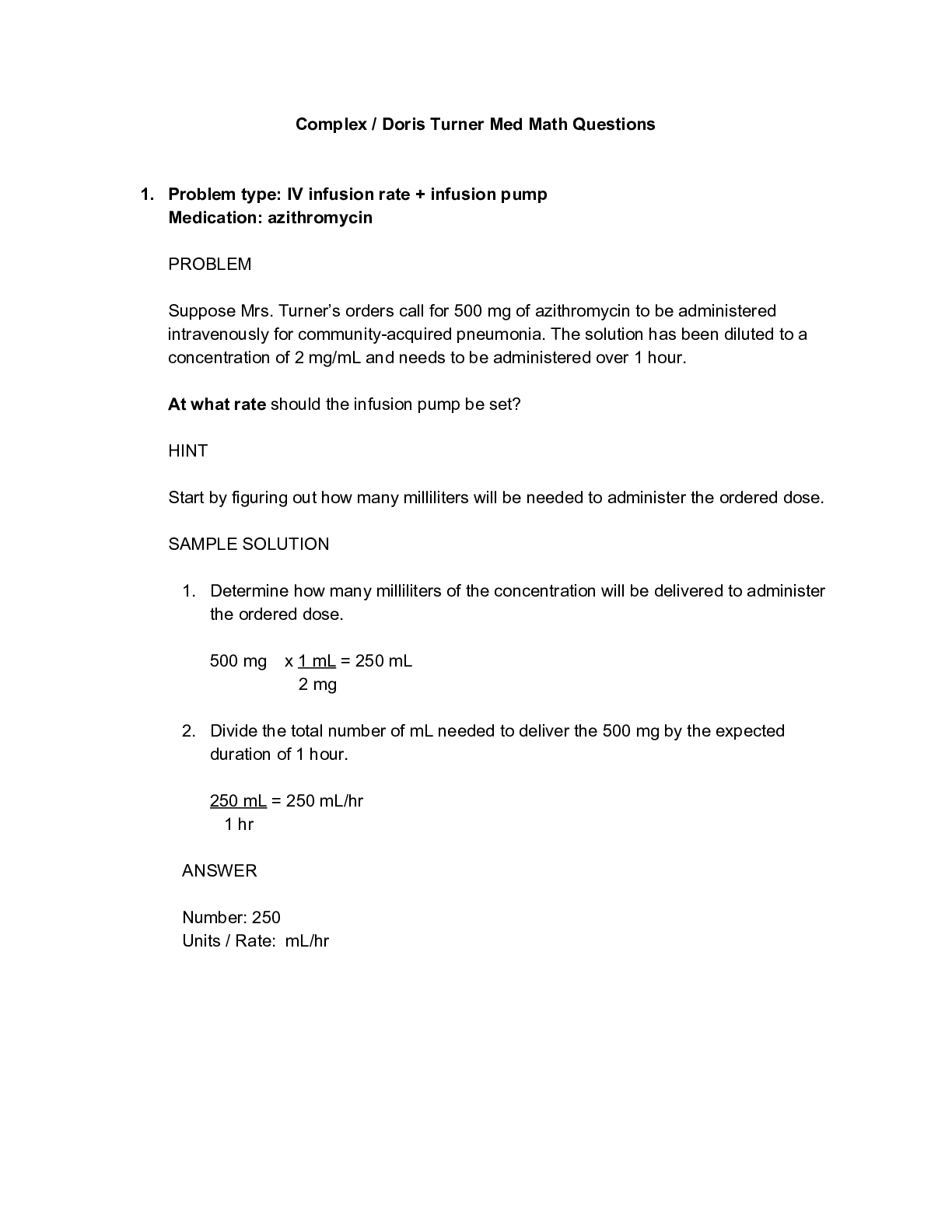
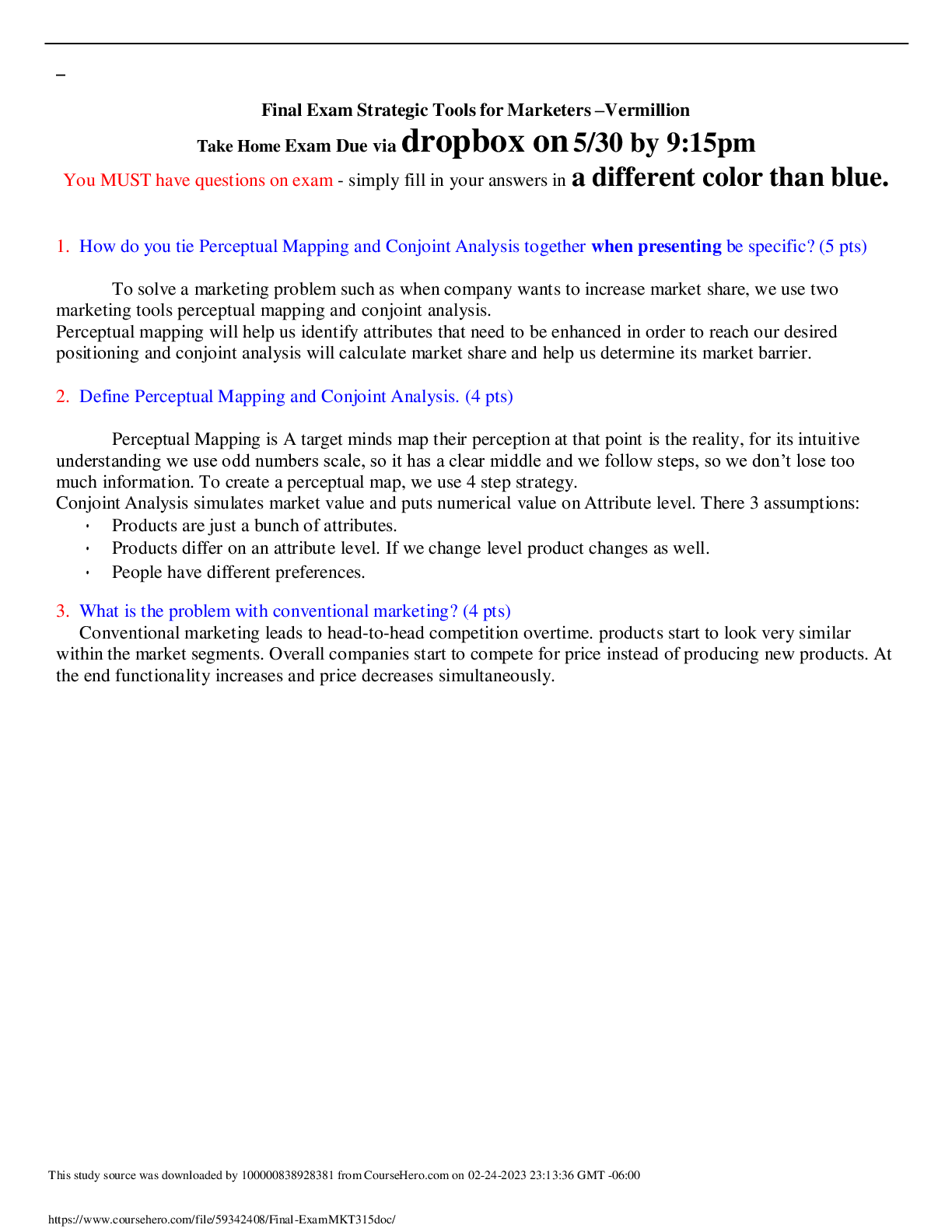
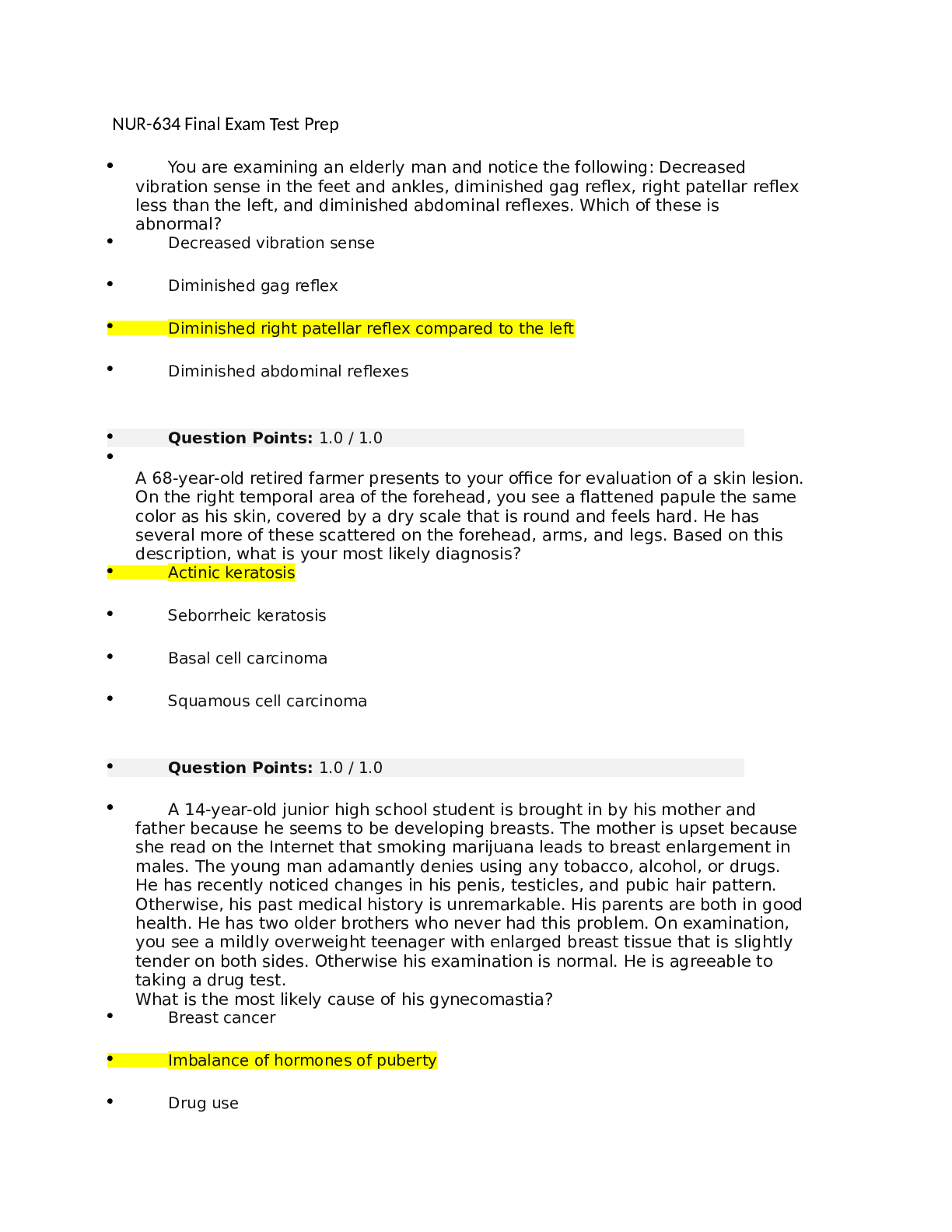
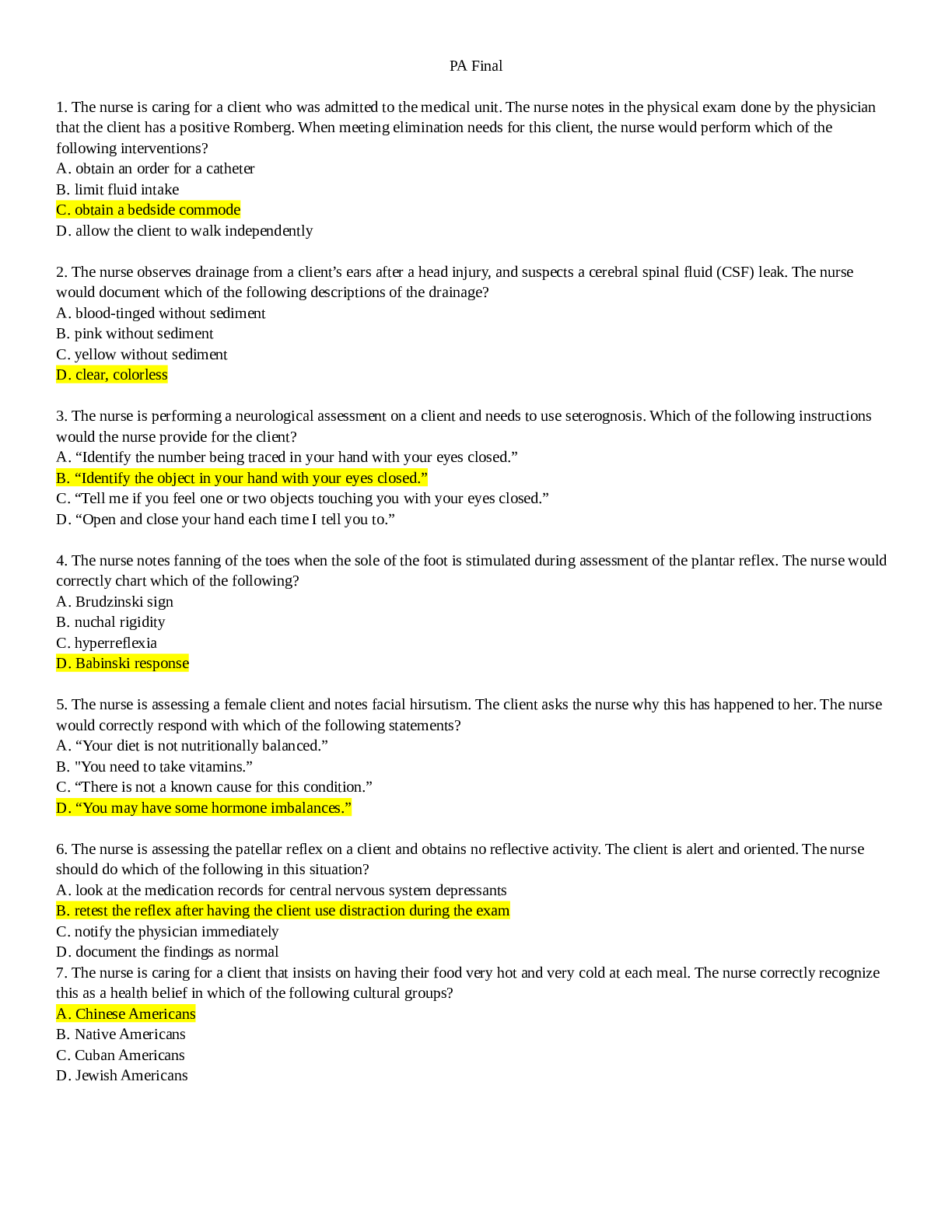



.png)
.png)
.png)
.png)
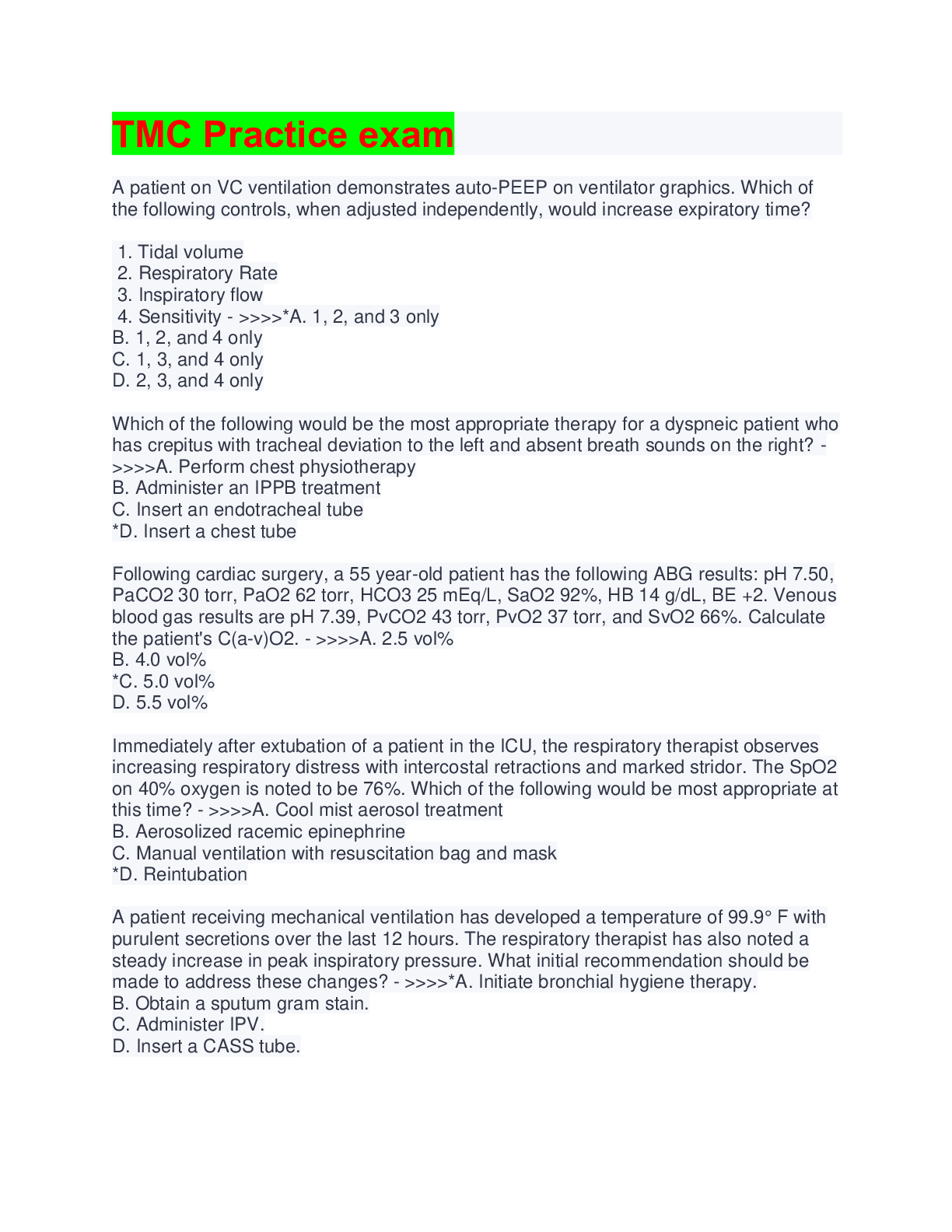
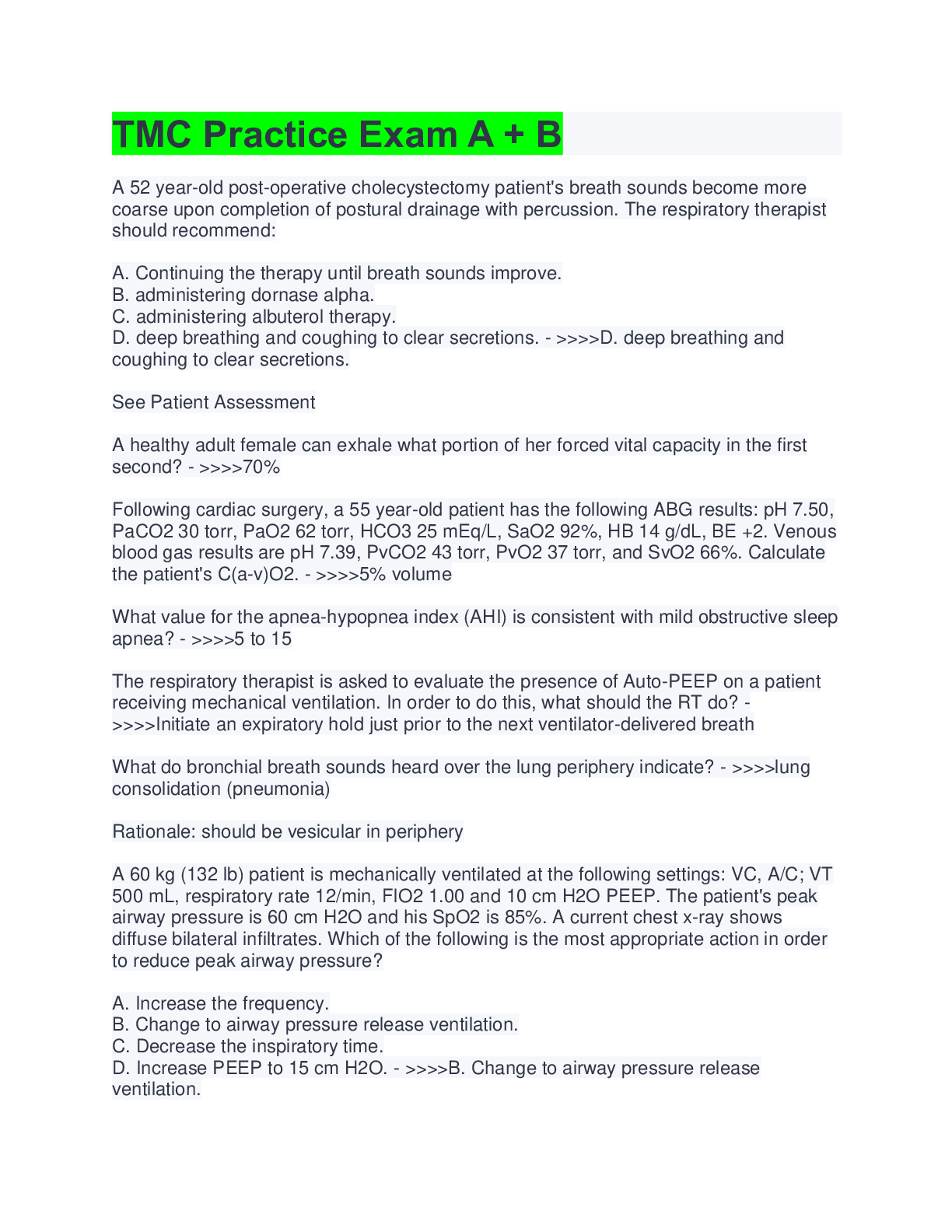
.png)
.png)
.png)
.png)
.png)
.png)
.png)
